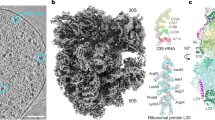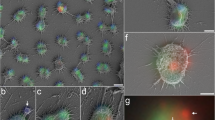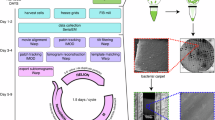Abstract
Fully understanding the biology of acid mine drainage (AMD) is central to our ability to control and manipulate its environmental impact. Although genomics and biogeochemical methods are relatively well established in the field, their combination with high-resolution imaging of intact members of microbial biofilm communities has not yet reached its full potential. Here, we used three-dimensional (3D) cryogenic electron tomography to determine the size and ultrastructure of intact ARMAN cells, a novel ultra-small archaeon, and sought evidence for their interactions with other members of its community. Within acid mine drainage biofilms, apparently free-living ARMAN cells from a deeply branched archaeal lineage have volumes of 0.009–0.04 μm3 (mean ∼0.03±0.01 μm3), only ∼92 ribosomes, yet are frequent hosts for replicating viruses. Organization within the periplasm and partitioning of ribosomes to the inner surface of the cytoplasmic membrane may be factors in size minimization. Most cells contain enigmatic tubular structures of unknown function. The low ribosome copy number per unit volume, indicative of slow growth rates and targeting of cells by diverse viruses may account for the low abundance of ARMAN cells compared with other biofilm community members. Our results provide the first 3D analysis of structural features of these novel and enigmatic cells and their interactions with at least two types of viruses. Our findings also emphasize that new biological phenomena remain to be discovered among lower abundance organisms from novel uncultivated lineages.
Similar content being viewed by others
Log in or create a free account to read this content
Gain free access to this article, as well as selected content from this journal and more on nature.com
or
References
Baker BJ, Banfield JF . (2003). Microbial communities in acid mine drainage. FEMS Microbial Ecol 44: 1–14.
Baker BJ, Tyson GW, Webb RI, Flanagan J, Hugenholtz P, Banfield JF . (2006). Lineages of acidophilic Archaea revealed by community genomic analysis. Science 314: 1933–1935.
Bond PL, Smigra SP, Banfield JF . (2000). Phylogeny of microorganisms populating a thick, subaerial, predominantly lithotrophic biofilm at an acid mine drainage site. Appl Environ Microbiol 66: 3842–3849.
Bremer H, Dennis PP . (1996). Modulation of chemical composition and other parameters of the cell growth rate in Escherichia coli and Salmonella: cellular and molecular biology. In: Neidhardt FC (ed). American Society for Microbiology, 2nd edn. 1553–1568 (http://ctbp.ucsd.edu/qbio/beemer96.pdf).
Comolli LR, Judd EM, Chen JC, Downing KH, Moerner WE, McAdams HH . (2005). Distinct constrictive processes, separated in time and space, divide Caulobacter inner and outer membranes. J Bacteriol 187: 6874–6882.
Cox RA . (2004). Quantitative relationships for specific growth rates and macromolecular compositions of Mycobacterium tuberculosis, Streptomyces coelicolor A3(2) and Escherichia coli B/r: an integrative theoretical approach. Microbiol 150: 1413–1426.
Folk RL, Taylor LA . (2002). Nanobacterial alteration of pyroxenes in Martian meteorite Allan Hills 84001. Meteoritics & Planetary Science 37: 1057–1069.
Gilbert RJ, Fucini P, Connell S, Fuller SD, Nerhaus KH, Robinson CV et al. (2004). Three-dimensional structures of translating ribosomes by Cryo-EM. Mol Cell 14: 57–66.
Giovannoni SJ, Tripp JH, Givan S, Podar M, Vergin KL, Baptista D et al. (2005). Genome streamlining in a cosmopolitan oceanic bacterium. Science 309: 1242–1245.
Glass JI, Assad-Garcia N, Alperovich N, Yooseph S, Lewis MR, Maruf M et al. (2006). Essential genes of a minimal bacterium. Proc Natl Acad Sci USA 103: 425–430.
Goldfarb DS . (2004). Microorganisms and calcium oxalate stone disease. Nephron Physiology 98: 48–54.
Huber H, Hohn MJ, Rachel R, Fuchs T, Wimmer VC, Stetter KO . (2002). A new phylum of Archaea represented by a nanosized hyperthermophilic symbiont. Nature 417: 63–67.
Hutchison III CA, Peterson SN, Gill SR, Cline RT, White O, Fraser CM et al. (1999). Global Transposon Mutagenesis and a Minimal Mycoplasma Genome. Science 286: 2165–2169.
Kajander EO, Çiftçioglu N . (1998). Nanobacteria: an alternative mechanism for pathogenic intra- and extracellular calcification and stone formation. Proc Natl Acad Sci USA 95: 8274–8279.
Kolisnychenko V, Plunkett III G, Herring CD, Fehér T, Pósfai J, Blattner FR et al. (2002). Engineering a reduced Escherichia coli genome. Genome Res 12: 640–647.
Kubitschek HE . (1990). Cell volume increase in Escherichia coli shifts to richer media. J Bacteriol 172: 94–101.
Lewin B . (1997). Genes VI. Oxford University Press: New York, ISBN 9780198577799.
Lewis PJ, Thaker SD, Errington J . (2000). Compartmentalization of transcription and translation in Bacillus subtilis. EMBO J 19: 710–718.
Malmstrom RR, Kiene RP, Cottrell MT, Kirchman DL . (2004). Contribution of SAR11 bacteria to dissolved Dimethylsulfoniopropionate and amino acid uptake in the North Atlantic Ocean. Appl Environ Microbiol 70: 4129.
Marr AG . (1991). Growth rate of Escherichia coli. Microbiol Rev 55: 316–333.
Martel J, Young D-E . (2008). Purpoted nanobacteria in human blood as calcium carbonate nanoparticles. Proc Natl Acad Sci USA 105: 5549–5554.
Mascarenhas J, Weber MHW, Graumann PL . (2001). Specific polar localization of ribosomes in Bacillus subtilis. EMBO Rep 21: 685–689.
Miteva VI, Brenchley JE . (2005). Detection and isolation of ultrasmall microorganisms from a 120,000-year-old Greenland Glacier Ice Core. Appl Environ Microbiol 71: 7806–7818.
Nicastro D, Schwartz C, Pierson J, Cho J-C, Giovannoni SJ, McIntosh JR . (2006). Three-dimensional structure of the tiny bacterium Pelagibacter ubique studied by cryo-electron tomography. Microsc Microanal 12: 182–190.
Ortiz JO, Förster F, Kürner J, Linaroudis AA, Baumeister W . (2006). Mapping 70S ribosomes in intact cells by cryoelectron tomography and pattern recognition. J Struct Biol 156: 334–341.
Prangishvili D, Forterre P, Garrett RA . (2006). Viruses of the Archaea: a unifying view. Nat Rev Microbiol 4: 837–848.
Ram RJ, VerBerkmoes NC, Thelen MP, Tyson GW, Baker BJ, Blake II RC et al. (2005). Community proteomics of a natural microbial biofilm. Science 308: 1915–1920.
Rappé MS, Connon SA, Vergin KL, Giovannoni SJ . (2002). Cultivation of the ubiquitous SAR11 marine bacterioplankton clade. Nature 418: 630–633.
Sheridan PP, Miteva VI, Brenchley JE . (2003). Phylogenetic analysis of anaerobic psychrophilic enrichment cultures obtained from a Greenland Glacier Ice Core. Appl Environ Microbiol 69: 2153–2160.
Steering Group for the Workshop on Size Limits of Very Small Microorganisms, National Research Council (1999). Size Limits of Very Small Microorganisms: Proceedings of a Workshop. National Academies Press: Washington, D.C., (http://www7.nationalacademies.org/ssb/nanomenu.html).
Waters E, Hohn MJ, Ahel I, Graham DE, Adams MD, Barnstead M et al. (2003). The genome of Nanoarchaeum equitans: insights into early archaeal evolution and derived parasitism. Proc Natl Acad Sci 100: 12984–12988.
Acknowledgements
This research was supported by The Director, Office of Science, Office of Basic Energy Sciences, of the US Department of Energy provided support under Contract No. DE-AC02-05CH11231 (LRC and KHD) and the US Department of Energy Genomics: GTL (JFB) program and by the NASA Astrobiology Institute (JFB). Mr Ted Arman (President, Iron Mountain Mines), Mr Rudy Carver, and Dr Richard Sugarek are thanked for site access and other assistance.
Author information
Authors and Affiliations
Corresponding author
Additional information
This article is dedicated to the life and work of Professor Terry Beveridge.
Supplementary Information accompanies the paper on The ISME Journal website (http://www.nature.com/ismej)
Rights and permissions
About this article
Cite this article
Comolli, L., Baker, B., Downing, K. et al. Three-dimensional analysis of the structure and ecology of a novel, ultra-small archaeon. ISME J 3, 159–167 (2009). https://doi.org/10.1038/ismej.2008.99
Received:
Accepted:
Published:
Issue date:
DOI: https://doi.org/10.1038/ismej.2008.99
Keywords
This article is cited by
-
Diversity, ecology and evolution of Archaea
Nature Microbiology (2020)
-
An archaeal symbiont-host association from the deep terrestrial subsurface
The ISME Journal (2019)
-
Eine oder zwei Membranen bei Prokaryoten: Was war zuerst da?
BIOspektrum (2019)
-
Cuniculiplasmataceae, their ecogenomic and metabolic patterns, and interactions with ‘ARMAN’
Extremophiles (2019)
-
Elusive data underlying debate at the prokaryote-eukaryote divide
Biology Direct (2018)



